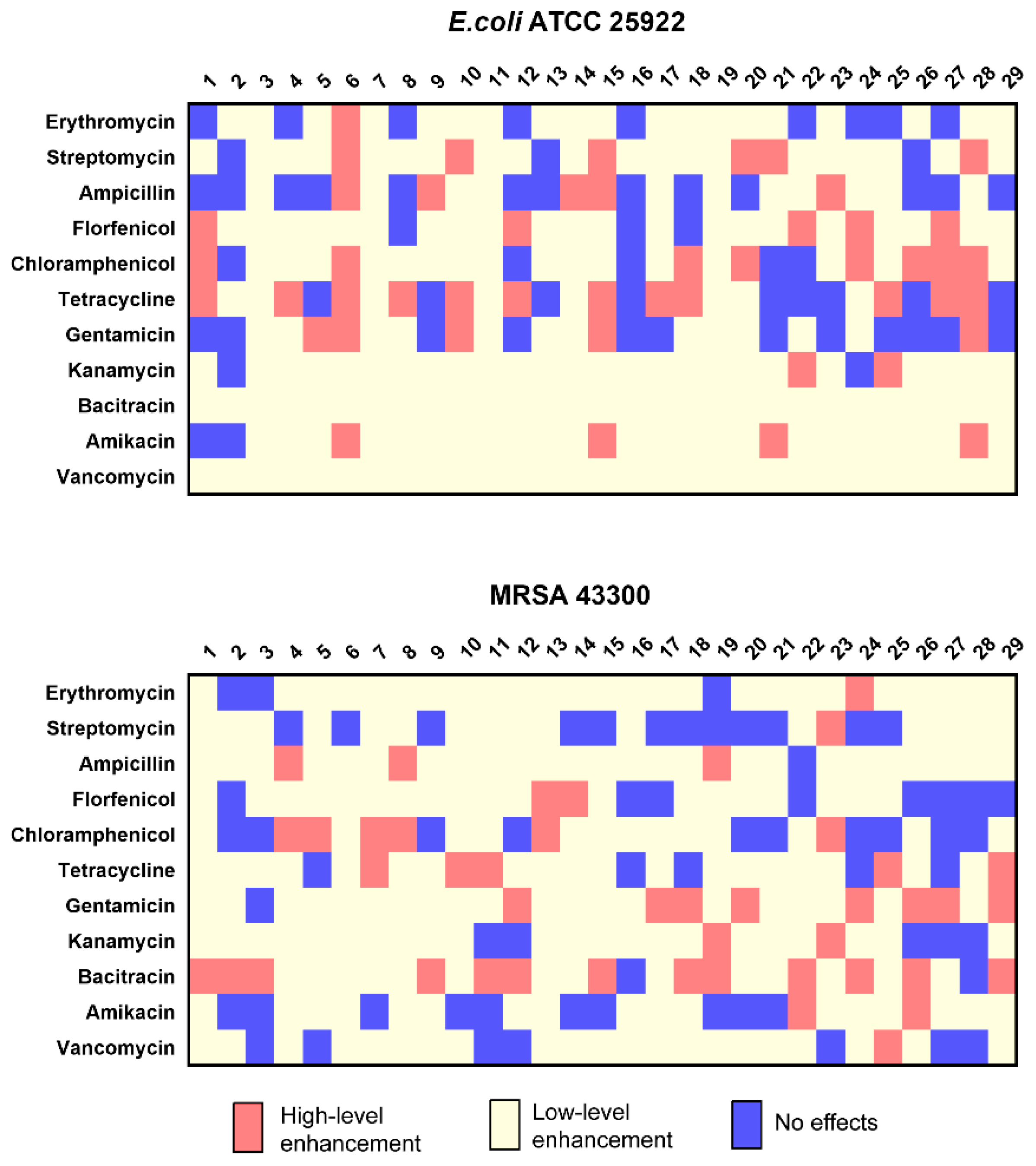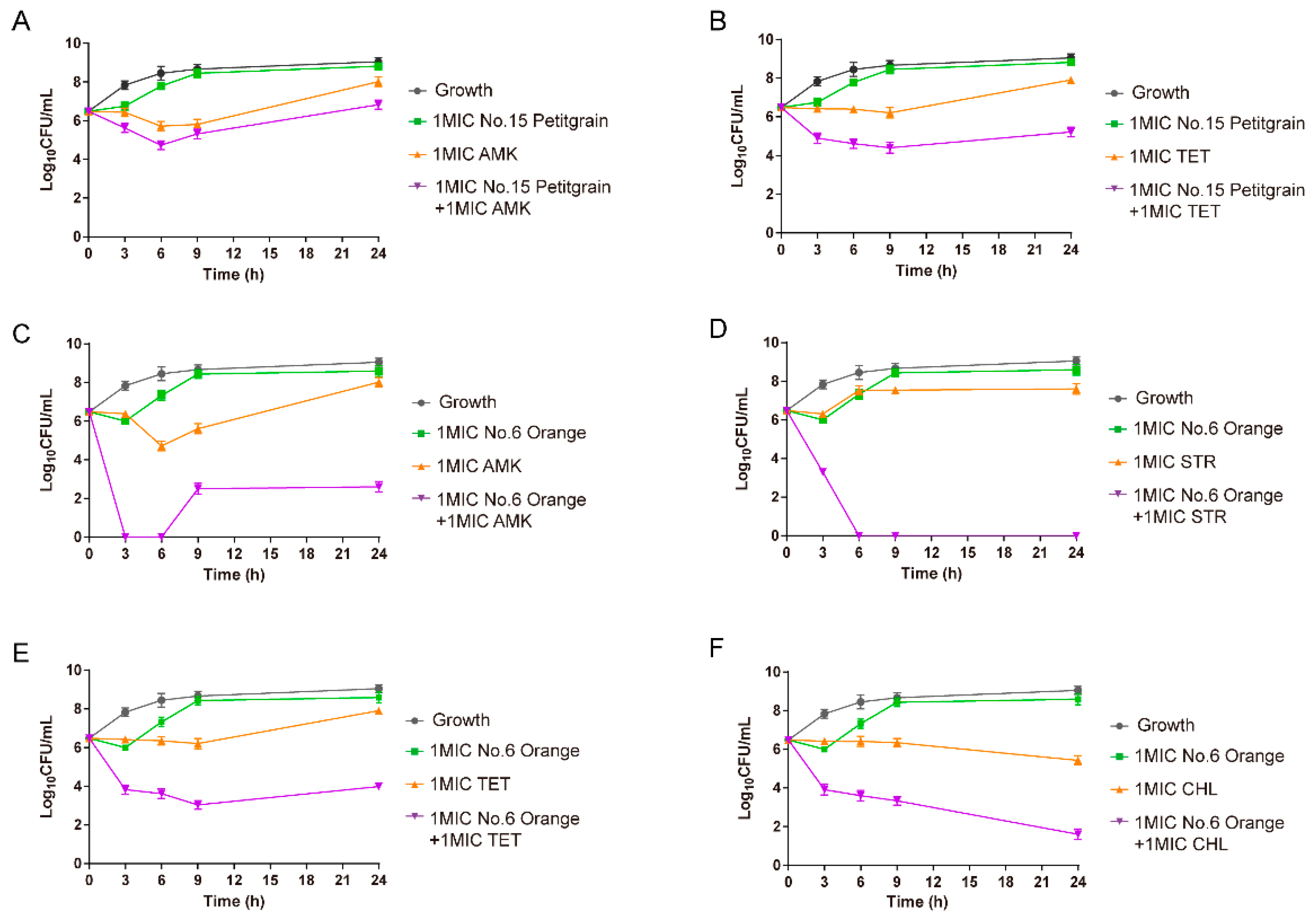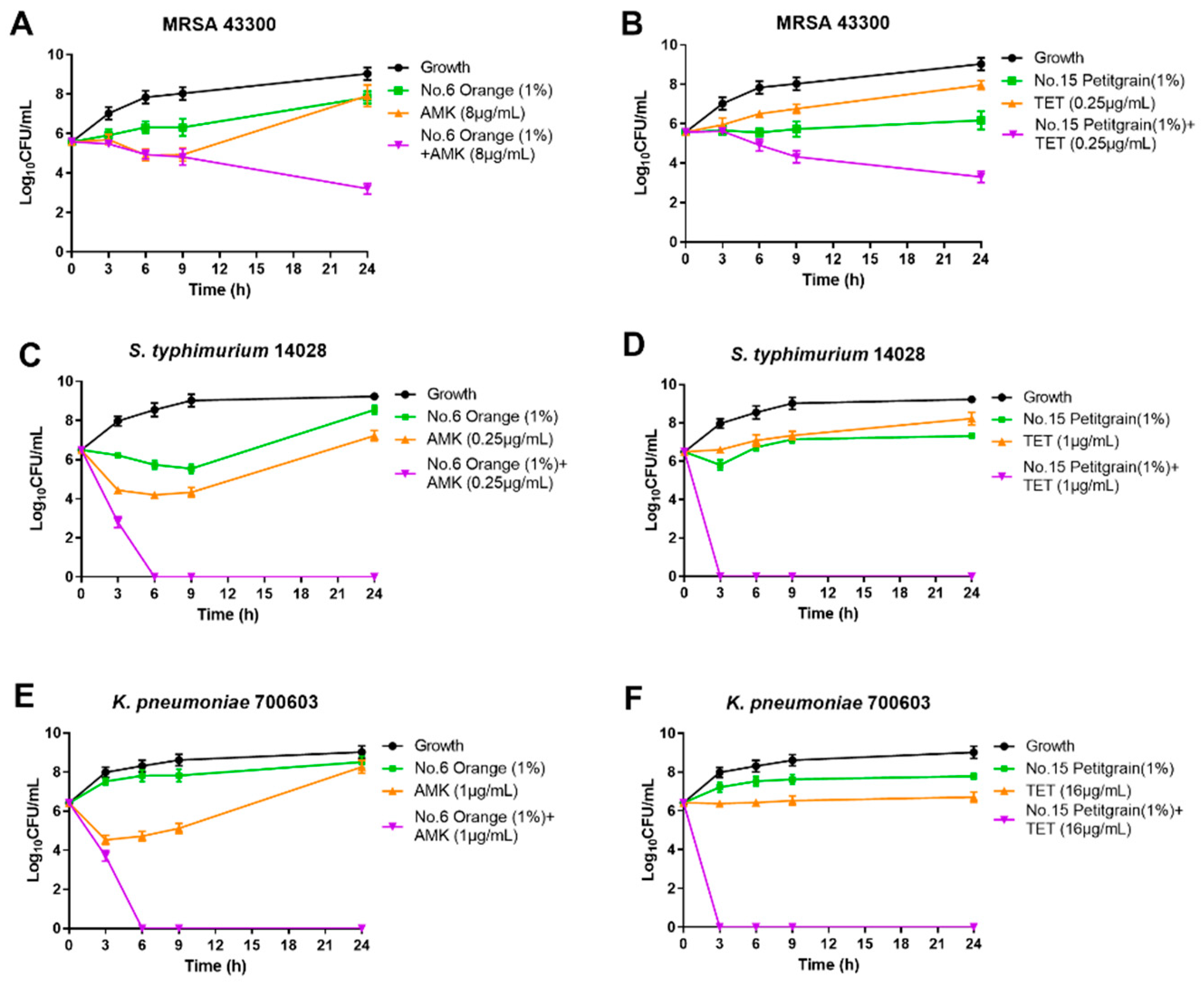Rapid Screening of Essential Oils as Substances Which Enhance Antibiotic Activity Using a Modified Well Diffusion Method
Abstract
:1. Introduction
2. Results
2.1. MIC Values of Essential Oils and Antimicrobial Agents
2.2. Effects of Essential Oils and Antibiotic Combinations
2.3. In Vitro Time-Killing Curves
3. Discussion
4. Materials and Methods
4.1. Antimicrobials and Essential Oils
4.2. Bacterial Strains and Growth Conditions
4.3. Determination of Minimum Inhibitory Concentration (MIC)
4.4. Screening for Synergistic Effects of Essential Oils with Antibiotics Using Modified Well Diffusion
4.5. Time-Kill Assays
4.6. Statistical Analysis
5. Conclusions
Author Contributions
Funding
Data Availability Statement
Conflicts of Interest
Appendix A


References
- Von Wintersdorff, C.J.; Penders, J.; van Niekerk, J.M.; Mills, N.D.; Majumder, S.; van Alphen, L.B.; Savelkoul, P.H.; Wolffs, P.F. Dissemination of Antimicrobial Resistance in Microbial Ecosystems through Horizontal Gene Transfer. Front. Microbiol. 2016, 7, 173. [Google Scholar] [CrossRef] [Green Version]
- Cantón, R.; Morosini, M.I. Emergence and spread of antibiotic resistance following exposure to antibiotics. FEMS Microbiol. Rev. 2011, 35, 977–991. [Google Scholar] [CrossRef] [PubMed] [Green Version]
- Brüssow, H. Infection therapy: The problem of drug resistance–and possible solutions. Microb. Biotechnol. 2017, 10, 1041–1046. [Google Scholar] [CrossRef] [PubMed]
- Brown, E.D.; Wright, G.D. Antibacterial drug discovery in the resistance era. Nature 2016, 529, 336–343. [Google Scholar] [CrossRef] [PubMed]
- Gupta, P.D.; Birdi, T.J. Development of botanicals to combat antibiotic resistance. J. Ayurveda Integr. Med. 2017, 8, 266–275. [Google Scholar] [CrossRef]
- Owen, L.; Laird, K. Synchronous application of antibiotics and essential oils: Dual mechanisms of action as a potential solution to antibiotic resistance. Crit. Rev. Microbiol. 2018, 44, 414–435. [Google Scholar] [CrossRef] [PubMed]
- Mahizan, N.A.; Yang, S.K.; Moo, C.L.; Song, A.A.; Chong, C.M.; Chong, C.W.; Abushelaibi, A.; Lim, S.E.; Lai, K.S. Terpene Derivatives as a Potential Agent against Antimicrobial Resistance (AMR) Pathogens. Molecules 2019, 24, 2631. [Google Scholar] [CrossRef] [Green Version]
- Chouhan, S.; Sharma, K.; Guleria, S. Antimicrobial Activity of Some Essential Oils-Present Status and Future Perspectives. Medicines 2017, 4, 58. [Google Scholar] [CrossRef] [Green Version]
- Yap, P.S.; Yiap, B.C.; Ping, H.C.; Lim, S.H. Essential oils, a new horizon in combating bacterial antibiotic resistance. Open Microbiol. J. 2014, 8, 6–14. [Google Scholar] [CrossRef]
- Zhou, Y.; Liu, S.; Wang, T.; Li, H.; Tang, S.; Wang, J.; Wang, Y.; Deng, X. Pterostilbene, a Potential MCR-1 Inhibitor That Enhances the Efficacy of Polymyxin, B. Antimicrob. Agents Chemother. 2018, 62. [Google Scholar] [CrossRef] [PubMed] [Green Version]
- Benameur, Q.; Gervasi, T.; Pellizzeri, V.; Pľuchtová, M.; Tali-Maama, H.; Assaous, F.; Guettou, B.; Rahal, K.; Gruľová, D.; Dugo, G.; et al. Antibacterial activity of Thymus vulgaris essential oil alone and in combination with cefotaxime against bla(ESBL) producing multidrug resistant Enterobacteriaceae isolates. Nat. Prod. Res. 2019, 33, 2647–2654. [Google Scholar] [CrossRef] [PubMed]
- Aelenei, P.; Rimbu, C.M.; Guguianu, E.; Dimitriu, G.; Aprotosoaie, A.C.; Brebu, M.; Horhogea, C.E.; Miron, A. Coriander essential oil and linalool–Interactions with antibiotics against Gram-positive and Gram-negative bacteria. Lett. Appl. Microbiol. 2019, 68, 156–164. [Google Scholar] [CrossRef] [PubMed]
- Balouiri, M.; Sadiki, M.; Ibnsouda, S.K. Methods for in vitro evaluating antimicrobial activity: A review. J. Pharm. Anal. 2016, 6, 71–79. [Google Scholar] [CrossRef] [PubMed] [Green Version]
- Zusman, O.; Avni, T.; Leibovici, L.; Adler, A.; Friberg, L.; Stergiopoulou, T.; Carmeli, Y.; Paul, M. Systematic review and meta-analysis of in vitro synergy of polymyxins and carbapenems. Antimicrob. Agents Chemother. 2013, 57, 5104–5111. [Google Scholar] [CrossRef] [PubMed] [Green Version]
- Foucquier, J.; Guedj, M. Analysis of drug combinations: Current methodological landscape. Pharmacol. Res. Perspect. 2015, 3, 00149. [Google Scholar] [CrossRef]
- Brochado, A.R.; Telzerow, A.; Bobonis, J.; Banzhaf, M.; Mateus, A.; Selkrig, J.; Huth, E.; Bassler, S.; Zamarreño Beas, J.; Zietek, M.; et al. Species-specific activity of antibacterial drug combinations. Nature 2018, 559, 259–263. [Google Scholar] [CrossRef]
- Gadisa, E.; Weldearegay, G.; Desta, K.; Tsegaye, G.; Hailu, S.; Jote, K.; Takele, A. Combined antibacterial effect of essential oils from three most commonly used Ethiopian traditional medicinal plants on multidrug resistant bacteria. BMC Complement. Altern. Med. 2019, 19, 24. [Google Scholar] [CrossRef] [PubMed]
- Zhang, Y.B.; Liu, X.Y.; Wang, Y.F.; Jiang, P.P.; Quek, S. Antibacterial activity and mechanism of cinnamon essential oil against Escherichia coli and Staphylococcus aureus. Food Control 2016, 59, 282–289. [Google Scholar] [CrossRef]
- Bassolé, I.H.; Lamien-Meda, A.; Bayala, B.; Obame, L.C.; Ilboudo, A.J.; Franz, C.; Novak, J.; Nebié, R.C.; Dicko, M.H. Chemical composition and antimicrobial activity of Cymbopogon citratus and Cymbopogon giganteus essential oils alone and in combination. Phytomedicine 2011, 18, 1070–1074. [Google Scholar] [CrossRef]
- Boukhris, M.; Simmonds, M.S.; Sayadi, S.; Bouaziz, M. Chemical composition and biological activities of polar extracts and essential oil of rose-scented geranium, Pelargonium graveolens. Phytother. Res. 2013, 27, 1206–1213. [Google Scholar] [CrossRef]
- Mehmood, B.; Dar, K.K.; Ali, S.; Awan, U.A.; Nayyer, A.Q.; Ghous, T.; Andleeb, S. Short communication: In vitro assessment of antioxidant, antibacterial and phytochemical analysis of peel of Citrus sinensis. Pak. J. Pharm. Sci. 2015, 28, 231–239. [Google Scholar] [PubMed]
- Pittman, C.I.; Pendleton, S.; Bisha, B.; O’Bryan, C.A.; Belk, K.E.; Goodridge, L.; Crandall, P.G.; Ricke, S.C. Activity of citrus essential oils against Escherichia coli O157:H7 and Salmonella spp. and effects on beef subprimal cuts under refrigeration. J. Food Sci. 2011, 76, M433–M438. [Google Scholar] [CrossRef] [PubMed]
- Muthaiyan, A.; Martin, E.M.; Natesan, S.; Crandall, P.G.; Wilkinson, B.J.; Ricke, S.C. Antimicrobial effect and mode of action of terpeneless cold-pressed Valencia orange essential oil on methicillin-resistant Staphylococcus aureus. J. Appl. Microbiol. 2012, 112, 1020–1033. [Google Scholar] [CrossRef] [PubMed] [Green Version]
- Federman, C.; Ma, C.; Biswas, D. Major components of orange oil inhibit Staphylococcus aureus growth and biofilm formation, and alter its virulence factors. J. Med. Microbiol. 2016, 65, 688–695. [Google Scholar] [CrossRef] [PubMed] [Green Version]
- Langeveld, W.T.; Veldhuizen, E.J.; Burt, S.A. Synergy between essential oil components and antibiotics: A review. Crit. Rev. Microbiol. 2014, 40, 76–94. [Google Scholar] [CrossRef]
- Gómara, M.; Ramón-García, S. The FICI paradigm: Correcting flaws in antimicrobial in vitro synergy screens at their inception. Biochem. Pharmacol. 2019, 163, 299–307. [Google Scholar] [CrossRef]
- Pinto, L.; Bonifacio, M.A.; De Giglio, E.; Cometa, S.; Logrieco, A.F.; Baruzzi, F. Unravelling the Antifungal Effect of Red Thyme Oil (Thymus vulgaris L.) Compounds in Vapor Phase. Molecules 2020, 25, 4761. [Google Scholar] [CrossRef]
- Sienkiewicz, M.; Łysakowska, M.; Kowalczyk, E.; Szymańska, G.; Kochan, E.; Krukowska, J.; Olszewski, J.; Zielińska-Bliźniewska, H. The ability of selected plant essential oils to enhance the action of recommended antibiotics against pathogenic wound bacteria. Burns 2017, 43, 310–317. [Google Scholar] [CrossRef]
- Semeniuc, C.A.; Pop, C.R.; Rotar, A.M. Antibacterial activity and interactions of plant essential oil combinations against Gram-positive and Gram-negative bacteria. J. Food Drug Anal. 2017, 25, 403–408. [Google Scholar] [CrossRef] [Green Version]
- Valgas, C.; de Souza, S.M.; Smania, E.F.A.; Smania, A. Screening methods to determine antibacterial activity of natural products. Braz. J. Microbiol. 2007, 38, 369–380. [Google Scholar] [CrossRef] [Green Version]
- Alizadeh Behbahani, B.; Imani Fooladi, A.A. Evaluation of phytochemical analysis and antimicrobial activities Allium essential oil against the growth of some microbial pathogens. Microb. Pathog. 2018, 114, 299–303. [Google Scholar] [CrossRef]
- Kruthi, B.S.; Srikari, K.; Priya, P.S.; Jyothi, C.; Gogte, S. In Vitro Testing of Antimicrobial Properties of Lemongrass, Eucalyptus and Their Synergistic Effect. Cheminform 1992, 23, 188. [Google Scholar]
- Swamy, M.K.; Akhtar, M.S.; Sinniah, U.R. Antimicrobial Properties of Plant Essential Oils against Human Pathogens and Their Mode of Action: An Updated Review. Evid. Based Complement. Alternat. Med. 2016, 2016, 3012462. [Google Scholar] [CrossRef] [PubMed]
- Mann, C.M.; Markham, J.L. A new method for determining the minimum inhibitory concentration of essential oils. J. Appl. Microbiol. 1998, 84, 538–544. [Google Scholar] [CrossRef]
- Sun, J.; Chen, C.; Cui, C.Y.; Zhang, Y.; Liu, X.; Cui, Z.H.; Ma, X.Y.; Feng, Y.; Fang, L.X.; Lian, X.L.; et al. Plasmid-encoded tet(X) genes that confer high-level tigecycline resistance in Escherichia coli. Nat. Microbiol. 2019, 4, 1457–1464. [Google Scholar] [CrossRef] [PubMed]
- Galvão, G.V.; Saviano, A.M.; Lourenço, F.R. Reduced incubation time for inhibition zone formation based on diffusion and growth mechanism elucidation. Analytical. Methods 2016, 8, 3885–3891. [Google Scholar] [CrossRef]
- Dong, C.L.; Li, L.X.; Cui, Z.H.; Chen, S.W.; Xiong, Y.Q.; Lu, J.Q.; Liao, X.P.; Gao, Y.; Sun, J.; Liu, Y.H. Synergistic Effect of Pleuromutilins with Other Antimicrobial Agents against Staphylococcus aureus In Vitro and in an Experimental Galleria mellonella Model. Front. Pharmacol. 2017, 8, 553. [Google Scholar] [CrossRef] [Green Version]



| Number | Essential Oils | Origin | MIC (v/v%) | Optimum Concentrations (v/v%) | ||
|---|---|---|---|---|---|---|
| E. coli | S. aureus | E. coli | S. aureus | |||
| 1 | Holly | Inadia | 2.500 | 5.000 | 100 | 100 |
| 2 | Cymbopogon citratus | India | 0.078 | 0.039 | 3.13 | 12.50 |
| 3 | Verbenone | France | 0.313 | 0.313 | 12.50 | 25 |
| 4 | Tangerine leaf | Italy | 0.313 | 2.500 | 100 | 100 |
| 5 | Tangerine | Italy | 0.625 | 1.250 | 12.50 | 12.50 |
| 6 | Orange | Italy | 1.250 | 0.039 | 25 | 50 |
| 7 | Lime oil | India | 0.313 | 0.625 | 6.25 | 12.50 |
| 8 | Lemon | Italy | 0.313 | 0.156 | 6.25 | 50 |
| 9 | Dill | Austria | 0.313 | 0.625 | 100 | 6.25 |
| 10 | Abies alba | Austria | 0.156 | 0.078 | 3.13 | 6.25 |
| 11 | Fennel | France | 2.500 | >5 | 100 | 100 |
| 12 | Pelargonium graveolens | Egypt | 0.039 | 0.039 | 25 | 50 |
| 13 | Tea tree | India | 0.156 | 0.078 | 6.25 | 6.25 |
| 14 | Abies sibirica | Austria | 0.156 | 0.156 | 6.25 | 25 |
| 15 | Petitgrain | France | 0.625 | 1.250 | 100 | 50 |
| 16 | Curcuma longa | India | >5 | 2.500 | 100 | 100 |
| 17 | Lavandula spica | France | 0.156 | 0.625 | 12.50 | 6.25 |
| 18 | Citrus paradisi | Italy | 0.625 | >5 | 6.25 | 100 |
| 19 | Cinnamomum cassia | India | <0.01 | 0.019 | 0.78 | 0.39 |
| 20 | Cinnamon Leaf | Sri Lanka | 0.019 | 0.039 | 0.78 | 6.25 |
| 21 | Eucalyptus globulus | Australia | 0.313 | 0.313 | 12.50 | 1.56 |
| 22 | Boswellia serrata | India | >5 | 2.500 | 50 | 100 |
| 23 | Carrot Seed | France | >5 | 0.313 | 100 | 100 |
| 24 | Cinnamomum zeylanicum | Sri Lanka | <0.01 | 0.039 | 0.78 | 6.25 |
| 25 | Piper nigrum | India | 2.500 | 1.250 | 100 | 12.50 |
| 26 | Pimpinella anisum | India | >5 | 5.000 | 100 | 100 |
| 27 | Trachyspermum ammi | India | 0.019 | 0.019 | 0.78 | 12.50 |
| 28 | Bergamot | India | 2.500 | 1.250 | 50 | 6.25 |
| 29 | Cupressu | France | 0.313 | 1.250 | 6.25 | 25 |
| Antibiotics | Classification | MIC (μg/mL) | Optimum Concentrations (μg/mL) | Inhibition Zones (mm) | |||
|---|---|---|---|---|---|---|---|
| E. coli | S. aureus | E. coli | S. aureus | E. coli | S. aureus | ||
| Ampicillin | Beta-lactam antibiotic | 2 | 1 | 1280 | 640 | 11 | 15 |
| Kanamycin | Aminoglycosides | 4 | 64 | 320 | 5120 | 14 | 10 |
| Erythromycin | Macrolides | 4 | >256 | 2560 | 5120 | 6 | 6 |
| Chloramphenicol | Amphenicols | 4 | 2 | 320 | 320 | 14 | 18 |
| Florfenicol | Amphenicols | 1 | 1 | 2560 | 160 | 17 | 16 |
| Streptomycin | Aminoglycosides | 8 | 2 | 320 | 320 | 14.5 | 14 |
| Amikacin | Aminoglycosides | 1 | 0.5 | 160 | 640 | 15 | 13 |
| Gentamicin | Aminoglycosides | 0.5 | 0.25 | 160 | 20 | 16 | 13 |
| Tetracycline | Tetracyclines | 1 | 0.125 | 160 | 20 | 14 | 13 |
| Bacitracin | Polypeptide | >256 | 64 | 5120 | 2560 | 6 | 14.5 |
| Vancomycin | Glycopeptides | >256 | 1 | 5120 | 160 | 6 | 15 |
Publisher’s Note: MDPI stays neutral with regard to jurisdictional claims in published maps and institutional affiliations. |
© 2021 by the authors. Licensee MDPI, Basel, Switzerland. This article is an open access article distributed under the terms and conditions of the Creative Commons Attribution (CC BY) license (https://creativecommons.org/licenses/by/4.0/).
Share and Cite
Cui, Z.-H.; He, H.-L.; Wu, S.-B.; Dong, C.-L.; Lu, S.-Y.; Shan, T.-J.; Fang, L.-X.; Liao, X.-P.; Liu, Y.-H.; Sun, J. Rapid Screening of Essential Oils as Substances Which Enhance Antibiotic Activity Using a Modified Well Diffusion Method. Antibiotics 2021, 10, 463. https://doi.org/10.3390/antibiotics10040463
Cui Z-H, He H-L, Wu S-B, Dong C-L, Lu S-Y, Shan T-J, Fang L-X, Liao X-P, Liu Y-H, Sun J. Rapid Screening of Essential Oils as Substances Which Enhance Antibiotic Activity Using a Modified Well Diffusion Method. Antibiotics. 2021; 10(4):463. https://doi.org/10.3390/antibiotics10040463
Chicago/Turabian StyleCui, Ze-Hua, Hui-Ling He, Shuai-Bin Wu, Chun-Liu Dong, Si-Ya Lu, Ti-Jiang Shan, Liang-Xing Fang, Xiao-Ping Liao, Ya-Hong Liu, and Jian Sun. 2021. "Rapid Screening of Essential Oils as Substances Which Enhance Antibiotic Activity Using a Modified Well Diffusion Method" Antibiotics 10, no. 4: 463. https://doi.org/10.3390/antibiotics10040463
APA StyleCui, Z.-H., He, H.-L., Wu, S.-B., Dong, C.-L., Lu, S.-Y., Shan, T.-J., Fang, L.-X., Liao, X.-P., Liu, Y.-H., & Sun, J. (2021). Rapid Screening of Essential Oils as Substances Which Enhance Antibiotic Activity Using a Modified Well Diffusion Method. Antibiotics, 10(4), 463. https://doi.org/10.3390/antibiotics10040463





